I returned two weeks ago from being away on vacation with a friend in New Zealand and Australia for 3.5 weeks. In case you also want to follow that trip, here's a link to the newest blog:
www.bergersadventures7.blogspot.com
After spending the last six weeks mostly in Spain, we took a quick morning flight from Sevilla to Lisbon, the capital of Portugal, a country that has been at the top of so many travel lists for the last couple of years at least. We were curious to see what all the 'hype' was about, but had only allocated ten days to explore the capital and two other cities north of there near the end of our 4.5 month long trip. It would give us a taste at least of what so many travel bloggers have been talking about and a sense of whether we'd want to return in the future for a longer hiatus. Hint: we definitely do!
Scenes I liked from one of the metro stops in Lisbon:
www.bergersadventures7.blogspot.com
After spending the last six weeks mostly in Spain, we took a quick morning flight from Sevilla to Lisbon, the capital of Portugal, a country that has been at the top of so many travel lists for the last couple of years at least. We were curious to see what all the 'hype' was about, but had only allocated ten days to explore the capital and two other cities north of there near the end of our 4.5 month long trip. It would give us a taste at least of what so many travel bloggers have been talking about and a sense of whether we'd want to return in the future for a longer hiatus. Hint: we definitely do!
Scenes I liked from one of the metro stops in Lisbon:
After finding our way to our third-floor apartment we'd rented in the very hilly city for the next five nights, we dumped our bags and began exploring our own Alfama neighborhood. Known as the colorful sailors' quarter, travel write Rick Steves wrote that it dated back to the age of Visigoth occupation from the 6th to the 8th centuries and was also a bustling district during the Moorish era before finally becoming the home of Lisbon's mariners. It was hard not to be struck immediately by the amount of graffiti we saw - we realized soon that it was not just limited to this area but sadly seemed to be typical of the entire city.
Nearby was the highest point in the city, the Sao Jorge Castle and its Gate that were part of a fortification that went back to the 11th century when Moors built it to house their army and provide a safe haven for the powerful people when they were under siege.
In the center of the terrace was a statue of Alfonso Henriques, a warlord with a strong personal army who founded Portugal in 1147 when he besieged the former Moorish castle for five months until the residents gave in. According to Steves, all school children know of their country's first king and Reconquista hero.
When the Christian noble Henriques called for help to vanquish the Moors from his newly founded Portugal, the Crusaders who helped him prayed to Sao Jorge or St. George as he's known in English. The castle's namesake is often portrayed slaying a dragon and, we remembered, was especially popular in Ethiopia.
Strolling along the ramparts we had marvelous views overlooking the Rio Tejo, one of five main rivers in the country but four of which come from Spain.
Looking southward, in the foggy distance we could just make out the Golden Gate-like 25th of April Bridge which led to the Cristo Rei or Christ the King statue on the other side of the river.
The castle's sloping walls were typical of castles of the period and were designed to withstand 14th century canon balls. Portugal's royalty lived in the castle until the 16th century when they moved to a palace. The castle became a military garrison and remained so even after suffering major damage in the 1755 earthquake. It became a national monument in the 20th century.
Even though we'd been told the castle was pretty stark and only contained rebuilt ruins, we still thought it warranted an hour or so of our time and it would be fun to walk along the castle's walls.
By now with all our travels, we've been in a few castles but none had walls that were as thick as these, we thought.
We really got a great sense of how big the city was while walking along the walls.
The Portuguese flag:
I was glad neither of us suffered from vertigo as the view into one of the inner courtyards would have been very uncomfortable, especially as the safety barriers were minimal.
You'd have liked seeing this Field Falcon canon from the end of the 14th century in one of the courtyards, Zachary.
We read in the small museum that the cities in what is now Portugal were characterized by their long-time Moorish presence just like so many cities we'd visited in Spain had also been. This was particularly evident in the country's ports where the city's heart was found in the medina or marketplace. Likewise, many of the foods still popular today in Portuguese cuisine come from the country's Arab roots. Evidence of that were the animal bones found that had been used for cooking.
If you've been reading my recent posts about the gorgeous tiles we saw all over Spain, you won't be surprised to know that the same use of tiles to cover walls and floors to make them more attractive became widespread also in Portugal at the end of the 15th century.
Until the end of the 16th century, smoking was an unknown habit to Europeans. The introduction of the tobacco plant in Europe can be traced to the Portuguese and Spanish navigators. Smoking was thought to help with many illnesses including migraines and gout. In the 17th century, pipe smoking became widespread and hundreds of manufacturing sites sprang up all over Europe to produce clay pipes composed of a bowl to hold a small amount of tobacco and a long shank of varying lengths. The latter were decorated with ornaments and the hallmarks of each production center.
Just outside the castle was a small neighborhood, known as Castle Town in English, that was built for Portuguese nobles to live close to their king.
The Church of the Castle was the oldest church in Lisbon.
Most of the houses in the neighborhood dated to the Middle Ages. Thanks to Steves' book, we went on a 'cultural scavenger hunt.' One of the things we saw were short doors that were tall enough for people five hundred years ago but definitely not now. Another was the noble family crest over some doors when important families wanted to be close to the king.
An unusual thing were the glass bottoms of bottles jutting out of house walls that were part of a space-efficient triangular contraption to dry clothes; when in use, sticks were inserted!
Many of the exteriors were adorned with decorated tiles.
The very attractive square. Largo Santa Lucia, was busy with old timers playing cards and plenty of fellow tourists admiring the terrace.
On the wall of the church facing the square were two 18th century images in tile. The first showed the Praca do Comercio or Commerce Square with the royal palace that was completely destroyed in the earthquake. The second one illustrated the reconquest of Lisbon from the Moors by Henriques.
From the terrace were drop-dead gorgeous panoramic views of the Alfama neighborhood that we were on our way to see. Of course, seeing the city bathed in a bright blue sky helped immensely!
One of Lisbon's iconic sights was its many trams but we sure learned quickly to be on the lookout for them before crossing streets!
The Museum and School of Portuguese Decorative Arts probably would have been an interesting stop to experience what a noble home looked like during the city's heyday but we'd had our fill of palatial homes after Spain and couldn't handle seeing one more just then!
After the Monastery of St. Vincent was constructed around 1600 by the Spanish king Philip II, he had this statue built to honor him.
So often Steven and I always seem to be climbing gazillions of stairs on our trips - it was so refreshing to walk down the long flight of stairs beside the fortified wall that once marked the boundary of Moorish Lisbon. It was amazing to think the stones had been stacked over a thousand years ago; they looked like they would last another thousand, too.
Part of the way down was a brightly colored cartoon mural under an arch that depicted Lisbon's history. That was definitely a first and a fun way to learn about the city's origins!
Did I tell you there were lots and lots of stairs down to the bottom?! Janina - I doubt even your new bionic knees could have taken them.
What a panic it would be here once a year when a positively insane mountain-bike street race takes place here from the castle to the sea! The sheer madness takes just two minutes.
At the bottom of all those stairs was the heart of the Alfama, the sweet Largo de Sao Miguel or St. Michael's Square with its attractive balconies and cafes. The tiny balconies could only be "one and a half hands" in width as part of a strictly enforced health initiative designed to keep the town open and well ventilated.
Steven was happy as even he felt like a giant in front of the tiny doorways!
It was common to see doors open and carafes of wine on small tables. We figured they may be expecting friends or they were for people to leave some money after taking a glass of vino - we weren't sure, though.
Traditionally the neighborhood here was tightly knit with families normally sitting down to communal dinners in the streets. Because few homes had their own bathrooms or washers, there was a public one in each neighborhood. The demographics have changed with many of the residents having chosen to live where there are more conveniences. Immigrant laborers moved in until the bad economy forced them to move. Now, the area is occupied by young bohemians.
Not far from the Alfama was the Fado Museum which paid homage to the fado music unique to Portugal just as flamenco belongs to Spain. I was really curious about learning about the unique musical style but Steven preferred to wait for me as he was tired from getting up early that morning.
I watched a wonderful video that explained, via absorbing interviews with several renowned fado singers, that their music spread from the ancient roots of Lisbon, from the tolerated margins of society to social acceptance over time. One singer explained the hope was that it reaches people's souls, that it is the Portuguese soul set to music. Another said it was a sort of literature for everyone, an "alchemy between a poem and music to create magic between the singers and the audience."
There was strong disagreement among the artists about whether fado music can be learned or whether it was intrinsic inside the singers from birth. Most seemed to agree that they learned from listening to other practitioners of the musical style.
After watching the engrossing video, I entered the museum proper. There, I discovered the earliest references to fado singing in the city dated from the second half of the 19th century when there was major political and institutional turmoil. As the city's working class began to get formally organized around 1860, fado became an important means of communication. It became associated with 'leisure charity parties' called cegadas and gradually became part of Lisbon's festivities. Fado became widely spread in theater stages by the end of the 19th century and the first historical documents on fado were published in the beginning of the 20th century.
In 1910 this urban song entered the fine arts with the painting O Fado by Jose Malhoa who drew inspiration from fado singers after spending 35 days straight in fado houses of music to get the details correct! The plaque by the painting noted the cigarette ash, the tablecloth, the painting of St. Anthony on the wall in the background of the painting - all details I would never have frankly taken the time to peer at.
The first representation of a fado singer was in this woodcut from 1872.
The first fado lyrics were usually anonymous and were conveyed by oral tradition. That changed at the beginning of the 1920s when the poems were associated with an illustrious group of popular poets.
The theme of fado music was center stage in this marvelous 1913 triptych which told the story of a sailor through three stages of his life. In the first, it depicts his nostalgia while at sea; in the middle one, the ship returns to port and he reunites with his family; and in the last painting, he's reading a letter and listening to a fado song while again at sea.
The English guitar was introduced in Lisbon and the nearby city of Porto at the beginning of the 18th century, mainly to accompany more educated musical pieces. The first reference to the 'Portuguese guitar' didn't appear until the beginning of the 20th century. It later became associated with fado music.
I didn't like leaving Steven any longer so hurried through the rest of the museum. I could have spent hours listening to music of specific fado artists but had been quite content with what I'd already been exposed to in the museum. I also knew we had reservations to go to a fado concert in a few days so would be able to experience the music first hand with Steven then.
"One cannot desire to become a fadista; one is born one." I left the museum still wondering! What I was convinced of, though, was that fado was a poem that could be heard and seen.
Photos of our stroll back to our apartment:
We were both struck by the striking architecture as it was so colorful and unusual and unlike what I normally think of as pretty boring architecture here in the US.
I hadn't thought of sardines for many decades until we came across this store selling them alone. I remember so well my father eating them after using the key in the top to open up the tin when I was a child growing up in Ottawa, Canada. I don't think, however, my mum, four brothers or I ever had them.
No, not bars of gold bullion but tin after tin of sardines!
Next post: Exploring much more of Lisbon.
Posted on April 8th, 2019, from back home in Denver.











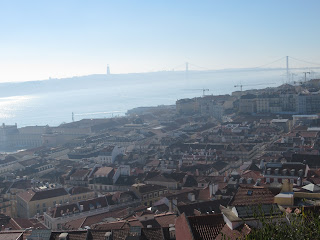




















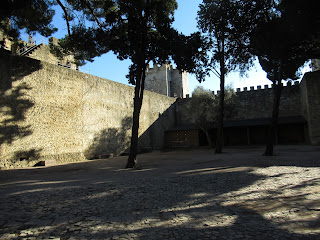































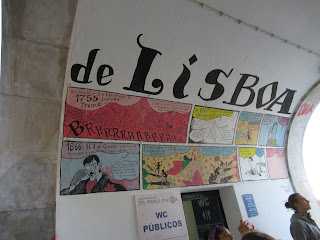



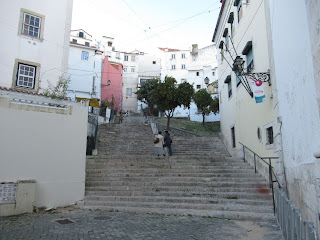



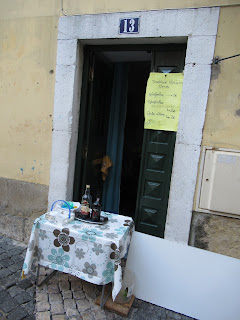

































I Loved the city of Lisbon when I visited it and I loved how you highlighted some of its most treasured sites (the Sao Jorge Castle; the ornately tiled buildings, Largo de Sao Miguel) ... thanks for the memories !
ReplyDelete